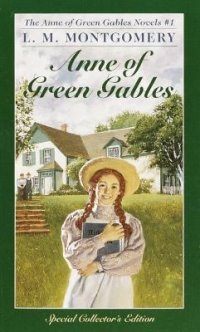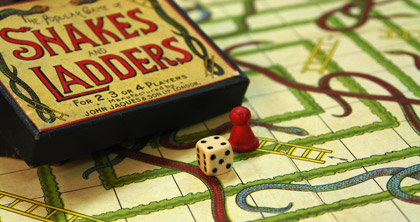“Tracing the legal principles behind a New York statute on lawyer deceit to a law adopted by the English Parliament in 1275, the New York Court of Appeals has determined that an attorney can be subject to treble damages in New York for an unsuccessful attempt to deceive a court. Responding to certified questions from the 2nd Circuit, the Court of Appeals ruled that the ‘unique statute of ancient origin’ was not a codification of common law fraud, and applied to attempted deceptions as well as successful ones.” [Joel Stashenko, New York Law Journal]
CPSIA and vintage books, cont’d: slicing the past
The article I wrote for City Journal Thursday on the legal fate of pre-1985 children’s books has been drawing all sorts of attention, and all I can acknowledge are a few of the highlights. Education expert Jay Greene and Darleen Click at Protein Wisdom are among those put in mind of Ray Bradbury’s novel Fahrenheit 451. “Of all the risks facing American children, old books must rank very, very low,” writes leading education blogger Joanne Jacobs. Will Benton: “Every time I learn something new about the CPSIA, I get more enraged.” Illinois blogger T. Varner notices an ad for a local thrift store saying it would no longer accept donations of a “very long list” of items including “children’s books published before 1985”; only later does it click. Hector Owen: “This is what happens when Congress passes these bloated bills that nobody reads, and the President signs them, and then we start to find out what was in there. Oh dear, what did they just do last week?” JDub at Ace of Spades: “Overlawyered has pretty much flooded the zone on this — I don’t want to simply link all of the things he’s got, so give him a look. … Go. Read. Be angry.” And Mark Bennett, of criminal law blog Defending People, gives it a mention in the course of hosting Blawg Review no. 199.

If you have time to read only one post from the weekend on the topic of CPSIA and books, however, make it Common Room‘s. She discusses, among other topics, the narrowness of the “collectibles for adult use” exception, the extra-vulnerable status of vintage kids’ nature and science books, which go out of print quickly and are seldom reprinted, and the fate of ex-library versions, beloved by book buyers on budgets. She also confesses to a temptation to slice the gorgeous illustrations out of certain books, a practice likely to be encouraged by CPSIA, if only because 1) the illustrations often have monetary value and might benefit from the defense that on their own they are not a product intended for children’s use; 2) the mutilated book that remains will be a less risky thing to donate, circulate or sell, since it is the color illustrations that are thought to pose the prime risk of containing infinitesimal lead exposures.* (More: as part of another good roundup, she calls our attention to this excellent Valerie Jacobsen post on why “marketing vintage children’s books as ‘adult collectibles’ will work for some children’s books, but only for a few.”)
Sierra Highlands, who like Common Room includes some beguiling illustrations, writes:
….so long as Google Books and Gutenberg are out there, the old books won’t be gone completely, but it hurts to hear of the beautiful old editions going out with tomorrow’s trash. It really, really hurts. There’s something about the physical presence of an old book that links us to our ancestors and to a world where books were loved enough to be put into beautiful editions. When I pick up an old book, often shabby on the surface but well handled, well made, well-loved, quiet but rich in form and content, I feel connected to the Permanent Things in body as well as spirit.

The BookShopBlog owner’s removal of six boxes of older children’s books from her shelves, mentioned here, also started an Etsy thread. Another poster at the same location had an idea for a national read-in day of protest for vintage books on the last day of National Library Week, Apr. 18.
Also, I was linked by a resource page on Anne of Green Gables and her creator, L.M. Montgomery, which made my week all by itself. I’ve started a special tag for CPSIA and books, distinct from the general CPSIA tag.
*Just to clarify the legalities once more: CPSIA does not make it unlawful to own pre-1985 kids’ books, nor does it ban the sale of such books when, as is true for many millions of them, they contain no lead in their pigments. But resellers cannot be sure which do and which don’t, and the law exposes them to liability should they stock a book with lead even if the misstep was in good faith and even if (of course) no child is hurt. The CPSC’s guidance provides a conspicuous safe harbor for the sale of books printed after 1985.
“Virginia Blogger Targeted With Outrageous Subpoena”
Sam Bayard at Citizen Media Law: “In perhaps the most blatant misuse of the subpoena power we’ve seen since the subpoena served on Kathleen Seidel of Neurodiversity last March, a lawyer for Thomas Garrett of Virginia has served a patently overbroad subpoena on blogger Waldo Jaquith, who publishes cvillenews.com, a community news blog about Charlottesville, Virginia.” Garrett is suing The Hook, a Charlottesville newspaper and associated website, for defamation, and Jaquith at his own publication covered that controversy in a blog post. Now, as part of his suit against The Hook, Garrett is demanding from Jaquith information to assist in identifying the many persons who commented on the post and even persons who merely viewed it.
CPSIA, board games and hobby gaming, cont’d

If you’re interested in older board games you may have gotten into the habit of haunting thrift stores, but over at leading gamer site Board Game Geek, they’re noticing that things are changing for the worse as shelves empty at many stores. Our earlier coverage of CPSIA’s likely impact on gaming is here.
February 16 roundup
- “Texas Judge Orders 178 Anonymous ‘John Does’ Who Posted on Topix Be Revealed” [Citizen Media Law]
- $4 billion lawsuit over racially insensitive Miley Cyrus eye gestures [Michelle Malkin, TMZ.com]
- Update: “Tulsa World drops lawsuit after writer apologizes” [Romenesko/Tulsa World, earlier]
- Also update: “Seventh Circuit Affirms Dismissal of John Lott’s Libel Lawsuit Against Steven Levitt” [Volokh, earlier]
- “M-I-C — Cease and desist! K-E-Y — Why? Because we caught you! M-O-U-S-E” [Ron Coleman]
- California: “Another Step Toward Shielding Good Samaritans From Civil Damages” [Calif. Civil Justice Blog, more]
- Montana lawmakers consider bill saying hazardous recreation goes on at your own risk [PoL]
- Senior writer at Wired decides to go work for Wal-Mart, what he found departed from the Barbara Ehrenreich formula [BoingBoing]
“We’re not allowed to display them, we’re not allowed to sell them”
“Acoustic radiation”
Some opponents of wind turbine farms in Maine say they’re concerned not just about audible noise but “low-frequency noise, so soft you can’t hear it,” from the installations, which they claim is linked to a wide array of health problems, not to mention “the strobe effect created by the sun setting behind the spinning blades, which some say can lead to seizures”. On an anti-turbine website, a New York doctor describes “acoustic radiation” as a mix of “audible sound, infrasound and vibration, in a pulsating character, that appear to trigger serious reported health problems in those families living near wind turbine installations.” State officials in Maine, on the other hand, would prefer to keep the focus on sound levels loud enough to actually be noticed:
The state’s chief medical officer has her doubts about turbine-related health effects. When it comes to potential hazards, “If anything, there’s evidence to put a moratorium on fossil fuels not on wind turbines,” Dr. Dora Ann Mills said Friday.
Disney thrill ride therapeutic, woman says
“A Florida woman who claims the G-forces from a theme park ride relieve her chronic pain has sued Walt Disney World for breaching its contract with visitors by limiting her to four rides per visit on its Tower of Terror. … In a complaint filed last month in Osceola County, Fla., Denise Mooty alleges she needs the Tower of Terror for therapy rather than thrills.” Disney denies the charges and says Mooty was made to leave the park “for causing a disturbance within the presence of other guests and using foul language toward a Cast Member.” [Heller, OnPoint News]
Bernard Madoff and Milberg Weiss, cont’d
A week ago I briefly noted that now-imprisoned securities class action king Mel Weiss appeared on the list of Bernard Madoff victims (163-pp. PDF courtesy WSJ, via Christopher Fountain) and observed how ironic it seemed that someone who made great claims to expertise in sniffing out stock fraud should have been taken in by it.
According to correspondence from New York securities lawyer (and longtime Weiss critic) Howard Sirota, however, there might be to the story than that:
I wouldn’t be so quick to jump to the conclusion that Mel Weiss [fouled] up investing with Madoff.
Weiss’ wife and son Stephen A. Weiss invested with Madoff, as did [Milberg Weiss partners] David Bershad and Pat Hynes.
In addition, convicted serial Milberg plaintiff Howard Vogel invested with Madoff.
Buchbinder Tunick, Milberg’s accountants and ironically Milberg’s principal forensic accounting experts, appear on the list, although the entries may be clients of the Buchbinder firm.
Class action firms Wolf Popper and Wolf Haldenstein also appear.
Sirota believes that other persons and entities on the Madoff victims list have also served as lead plaintiffs in securities litigation or as plaintiffs in other litigation handled by class-action firms. All of which could be mere coincidence, or could suggest that either Madoff himself or others in his circle might have played some role in funneling lead plaintiffs to the class-action bar. (Particularly in the “race to the courthouse” era that preceded the Private Securities Litigation Reform Act, having a stable of cooperative repeat plaintiffs was vital to the success of many plaintiff’s firms.)
One way to check this thesis, Sirota suggests, would be to check the names on the Madoff victims list against those on the list of plaintiffs maintained by the Stanford Law School securities class action clearinghouse to see whether there are any other noteworthy matches and if so whether they follow any particular pattern. He also asks whether some of the law firms that have been organizing task forces to recruit and represent plaintiffs in the Madoff scandals — they include the Milberg firm and Wolf Haldenstein — have adequately disclosed to potential clients in their literature that their firms’ own names figure on the Madoff victims list. More: Gary Weiss, Larry Ribstein.
Further: Yet more views. And in comments, a visitor says Wolf Haldenstein is on the list because clients of the firm invested with Madoff, not because the firm itself did.
Snopes and CPSIA
How wrong — and how seemingly unembarrassed about being wrong — is the popular urban-legends site? After I raised the question on Friday, reader Meredith Wright wrote the site and got a highly unsatisfactory response, which I’ll reprint here (and have also printed in comments):
Comment (MW): First of all, I LOVE your website, and usually find it well-sourced. But your inboxer article on CPSIA is just incorrect. CPSIA is a poorly written law (and apparently a poorly READ law – most of the representatives and senators who voted for it never bothered to read it – kind of like the PATRIOT Act), but it IS going to impact a LOT of people who shouldn’t have to suffer, mostly small business owners and LIBRARIES.
Go to Overlawyered.com and check it all out. I have no ax to grind here
(although my representative is Waxman, one of the morons who wrote this stupid bill) and just want you to take a look at the other side of the
issue. At the very least, your article should be labeled “undetermined” not “false.”Kind regards,
Meredith Wright
And the response:
From: snopes.com [email redacted]
Subject: Re: snopes.com: Page Comment
To: Meredith Wright [email redacted]
Date: Friday, February 13, 2009, 6:43 PMIt’s covered in our FAQ at http://www.snopes.com/info/faq.asp
Many of the texts we discuss contain a mixture of truth, falsity, and exaggeration which cannot be accurately described by a single “True” or “False” rating. Therefore, an item’s status is generally based upon the single most important aspect of the text under discussion, which is summarized in the statement made after the “Claim:” heading at the top of the page. It is important to make note of the wording of that claim, since that is the statement to which the status applies.
Urban Legends Reference Pages
http://www.snopes.com
* * *
So [this is W.O., editorializing, now, not Snopes or Wright] it doesn’t matter how often people read the Snopes item and conclude that the alarms over resellers and CPSIA are unfounded, hysteria, far-fetched, etc. The posting was narrowly accurate when it came to refuting one particular false sub-rumor, and so there’s no need to apologize for, let alone correct, the dismissive tone and poorly informed opinionizing on prospects for enforcement that led many readers into a wider and more serious error, namely thinking that children’s resellers who don’t “blatantly take a cavalier attitude” about customer safety would have no trouble living with the law’s requirements. If you believed Snopes on that, you would have been grossly unprepared for the convulsions in the children’s resale business that began making headlines in recent days.
Incidentally, for those keeping score, the Snopes entry gets other facts about the law wrong too. For example, it announces that “children’s products made after [emphasis added] February 10, 2009″ face lead certification requirements. This was not true either before or after the CPSC’s 11th-hour stay of certification enforcement: it was and is the date of sale or distribution, not of manufacture, that triggers the requirements. A small maker or dealer relying on the Snopes piece might have concluded that its pre-2/10 stocks were not affected by the certification controversy — big, big mistake.
(Public domain image: Grandma’s Graphics, Margaret Tulloch).

